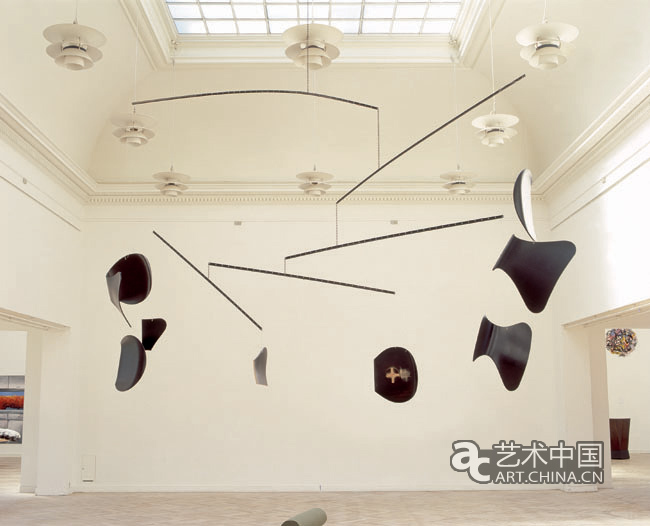马丁博伊斯 - 活动装置(与你在一起就像新的过去) |
| 艺术中国 | 时间: 2010-01-29 18:36:36 | 文章来源: 艺术中国 |
|
马丁博伊斯 -《活动装置(与你在一起就像新的过去)》 Martin Boyce Mobile (Being With You Is Like The New Past) 2002 Mixed painted steel, chain, wire, altered Jacobsen 3107 chairs Dimensions variable 马丁 .博伊斯 活动装置(与你在一起就像新的过去),2002 混合涂层钢板,链条槽,线材,雅各布森3107椅子 可变尺寸
马丁•博伊斯的作品里总是有鬼魂出现,《活动装置(和你在一起就像新的过去)(Mobile (Being with you is like the new past))》也不例外。第一眼看去,作品中悬挂的形状奇异的深色阴影,像神秘的鬼魂一样漂浮在空气中,既优雅又诡异。与1931年发明了现代流动艺术的亚历山大•考尔德的作品相比,博伊斯作品的结构更具阴暗不祥的气息。但是,博伊斯雕塑中漂移着的不是卡尔德钟爱的典型抽象形状,而是丹麦建筑师和设计师阿尔尼•雅克布森设计的椅子的零件。这些椅子零件源自于雅克布森于1955年设计的《3107椅子》,也叫“系列7”椅子,是雅克布森最知名的设计作品。 从这一时期起,博伊斯的多数作品中就都表现了他对现代主义设计和建筑的标志符号的迷恋,同时还有包含在留存物品中的持续气氛和思想意识。除雅克布森之外,设计师查尔斯和蕾•伊默斯对这一时期的博伊斯也产生了重要影响。他的这一系列作品蕴含虚幻鬼魂般的气质,经常被归入大气环境类,可以用“不死的梦想”来描述。他2003年创作的通风网栅雕塑就用这个词组命名为《幻肢(不死的梦想)(Phantom Limb (Undead Dreams))》 ,这件同时期的雕塑作品以伊默斯的“夹板雕塑(Splint Sculpture)”(1942)为基础,其原型在博伊斯的作品中变形之后以类似卡通幻象的形式再现。 在某种程度上说,这里比较危险的一个概念就是从20世纪中期开始在美国制造业中渐渐普遍的“内在陈旧性”概念,即经济的迅速发展是以人们愿意丢弃旧物为支柱。尤见于这一时期的加利福尼亚现代主义设计梦想,其基础就是一个对战后经济的乌托邦式的解决方案:能够改变普通家庭生活方式的可用物品。然而,随着时间的推移,这些“经典”设计却成为了专属富人和受过高等教育人群的奢华商品。博伊斯的作品《移动》对民主设计和“功能决定形式”的原则加以讽刺嘲笑,因为作品中的椅子和靠背都挂在无法触及的地方,根本不能使用。博伊斯对这些设计“符号”的重构暗喻着现代主义本身从最初开始就包含内在性陈旧。正如威尔•布拉德利所说:现在走近这些50年之久的鬼魂揭示了现代主义的“情感联系”——不仅仅在于思想的联系,也在于“接受某些形式策略可以实用性地表现那些思想。现在那种接受已经消失了。很少有人会傻到认为美丽的鲜花或睿智的设计能填补我们社会和政治结构上的鸿沟空洞。” 然而,如果可以呢?这些椅子、这些设计中还保留着什么样未曾开发的乌托邦式的希望呢?是不是能够从中看出另一个未来或现在呢?博伊斯流动设计作品的副标题“和你在一起就像新的过去”暗示着作品与时间的独特关系。与某人“在一起”指现在,至少是相对的现在,而使用“新的”过去又放宽了作品的瞬时性。博伊斯在谈到自己的作品和伊默斯的雕塑时说,它们是创造了原型的“脱轨的”形式,这些物品本来是会在平行的道路上存在于现在。我们很难说这些重构后的物品究竟是来自更好的还是更糟 的时代,但是,正如博伊斯所说,它们都充满了截然不同的、波动变化的潜力。它们在地面上迂回盘旋,保持一种悬而未决的状态,幽灵鬼魂似的在这里等待着其他想象中的未来。 L.M.F. Ghosts are ever present in the work of Martin Boyce, and Mobile (Being with you is like the new past) is no exception. At first glance, what appear to be oddly formless, dark shapes hang from a mobile, floating in the air like unlikely spirits, with a mixture of grace and awkwardness. The structure of the work suggests a more ominous rendering of the mobiles of Alexander Calder, who invented the modern mobile in 1931. Suspended in Boyce’s sculpture, however, are not the distinctly abstract shapes of which Calder was fond, but parts of chairs designed by the Danish architect and designer Arne Jacobsen. The parts come from the 3107 Chair, designed in 1955, also known as the ‘series 7’ chair, perhaps the design for which Jacobsen is best known. As in much of Boyce’s work from this period, there is a fascination with icons of Modernist design and architecture, and with the continuing atmospheres and ideologies that might be contained within the remaining objects. As well as Jacobsen, the designers Charles and Ray Eames play an important role for Boyce at this time. The ghostly atmosphere of this series of works, often grouped together in atmospheric environments, might be encapsulated by the phrase ‘undead dreams’, which can be read on the artist’s sculptures of ventilation grills. Phantom Limb (Undead Dreams) (2003) , a contemporaneous work, is a sculpture based on an Eames ‘Splint Sculpture’ (1942), which reappears in Boyce’s work, altered, and resembling a cartoon phantom. What is, to some extent, at stake here is the idea of built-in obsolescence that was becoming common in American manufacturing in the mid 20th century, with a burgeoning economy supported by a willingness to discard objects. The dreams for Modernist design, particularly seen in California during this period, were based in utopian solutions for a post-war economy: usable objects that might change the way the average family lived. Ultimately, however, over time these ‘classic’ pieces of design became luxury commodities for the rich and educated. In Mobile, the principles of democratic design and ‘form follows function’ are ridiculed, as the chairs’ seats and backs dangle out of reach, impossible to use. Boyce’s reframing of these design ‘icons’ speculates that Modernism itself also contained built-in obsolescence from the start. Approaching these 50-year-old ghosts now, as Will Bradley has commented, reveals the ‘emotional bond’ of Modernism – not only in relation to ideas, but in ‘the acceptance that certain formal strategies could usefully represent those ideas. That acceptance has gone. Few people, now, would be fooled into thinking that pretty flowers or even thoughtful design could bridge the gaping holes in our social and political structures.’ And, yet. What if? What utopian hope remains in these chairs, these designs, untapped? Is another, alternative future or present discernible? The subtitle of Boyce’s mobile, Being with you is like the new past, hints at the work’s peculiar relationship to time. ‘Being with’ someone connotes the present, or at least presentness, but the invocation of a past that is ‘new’ loosens its temporality. Boyce has spoken of his work with Eames OW MANYsculptures as creating ‘derailed’ versions of the original – objects that might have ended up in the present via a parallel route. Whether these objects come from a time that is better or worse is hard to say. However, as rendered by Boyce, they are charged with different, fluctuating potentials. They hover, above the ground, in a kind of limbo, a spectral waiting area for other imagined futures. L.M.F. |
| 注:凡注明 “艺术中国” 字样的视频、图片或文字内容均属于本网站专稿,如需转载图片请保留 “艺术中国” 水印,转载文字内容请注明来源艺术中国,否则本网站将依据《信息网络传播权保护条例》维护网络知识产权。 |
